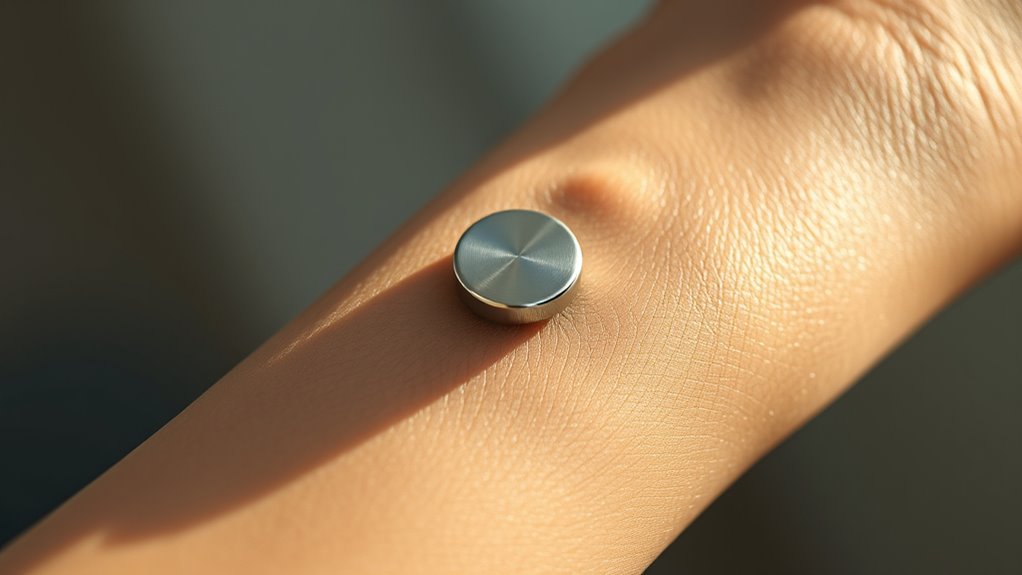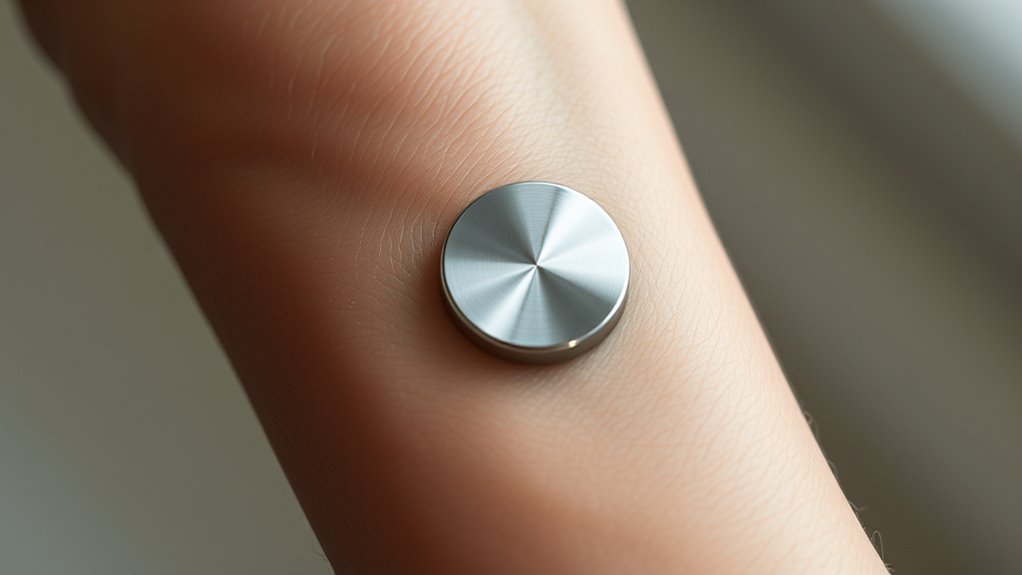Magnet implants are a cutting-edge sensory piercing technology that embeds small, biocompatible magnets under your skin, offering a discreet and customizable way to enhance perception or express personal style. These implants involve a minor surgical procedure and can be placed in various locations for a subtle or striking effect. While they open exciting creative possibilities, it’s essential to contemplate safety, potential risks, and long-term care. Exploring further will reveal how these innovative devices balance aesthetics with advanced safety measures.
Key Takeaways
- Magnet implants are small, biocompatible devices embedded under the skin to enable sensory perception of magnetic fields.
- They utilize advanced materials and miniature magnetic technology for safe and discreet sensory enhancement.
- Proper implantation involves sterile procedures by experienced practitioners to minimize infection and rejection risks.
- These implants can be customized for visibility or subtlety, offering aesthetic and sensory expression options.
- Ongoing monitoring and maintenance are essential for safety, with considerations for regulation, long-term effects, and potential removal.

Magnet implants are small, biocompatible devices embedded under the skin that allow you to interact with magnetic fields in innovative ways. This technology opens up new possibilities for sensory enhancement and personal expression, but it also raises important questions about safety and aesthetics. When considering a magnet implant, you’ll want to weigh the potential risks against the visual appeal and how it fits your overall look. The safety concerns surrounding magnet implants are valid; although the devices are designed to be biocompatible, there’s always a chance of infection, rejection, or migration if not properly implanted or if aftercare isn’t maintained. It’s vital to seek out experienced, professional practitioners who follow strict sterilization protocols. You should also be aware of the possibility of interference with electronic devices, such as pacemakers or other medical implants, which could be affected by the magnetic field.
Additionally, understanding regulatory considerations can help you make more informed choices about such experimental modifications. Aesthetic considerations play a significant role in your decision to get a magnet implant. The small device is typically discreet, but it can also be customized to match your skin tone or personal style. Some choose to have the implant placed in visible areas, like fingertips or behind the ear, to showcase their tech-savvy or futuristic vibe, while others prefer it in less conspicuous spots for a more subtle look. You might worry about how the implant will age with your skin or how visible it will be over time. Additionally, the process itself involves a minor surgical procedure, which can leave a small scar or bump if not performed carefully. It’s worthwhile to think about how the implant will complement your overall aesthetic and whether you’re comfortable with the permanence and visibility of the device.
While the idea of embedding a magnet under your skin might seem exciting, you should also consider the long-term implications. Regular monitoring and maintenance might be necessary to guarantee the implant stays secure and functions properly. If you decide to remove it later, you’ll need to undergo another procedure, which could leave residual scarring or tissue changes. Ultimately, your decision should balance curiosity and innovation with safety and appearance. As the technology advances, these devices are becoming safer and more refined, but being informed and cautious will help you make choices aligned with your personal preferences and health. Whether for sensory enhancement, artistic expression, or technological experimentation, magnet implants are a bold step into the future, but it’s vital to approach them thoughtfully.
Frequently Asked Questions
How Long Do Magnet Implants Typically Last?
Magnet implants usually last several years, but their durability depends on factors like body chemistry and implant type. Over time, you might notice a decrease in magnetic strength, which could indicate the need for implant removal or replacement. Proper care can extend their lifespan, but if you experience discomfort or other issues, consult a professional. Remember, implant durability varies, so regular check-ups help guarantee your sensory piercing remains safe and effective.
Are Magnet Implants Safe for Children or Teenagers?
Imagine a tiny magnet in your body—sounds futuristic, right? But when it comes to children and teenagers, safety concerns are real. You should know that magnet implants aren’t typically recommended for minors, as child safety and teenage considerations demand extra caution. The risks aren’t fully understood, and their developing bodies could react unpredictably. So, it’s best to wait until they’re older and consult medical professionals before considering such implants.
What Are the Potential Long-Term Health Risks?
When considering long-term health risks of magnet implants, you should be aware of potential issues like magnet rejection and skin irritation. Over time, your body might reject the magnet, leading to inflammation or infection. Skin irritation can occur if the implant causes discomfort or reacts with your skin. Regular monitoring and proper aftercare are essential, but these risks highlight why it’s vital to carefully weigh the benefits against possible health concerns.
Can Magnet Implants Interfere With Medical Devices?
Like a magnet pulling metal shavings, magnet implants can cause magnetic interference with medical devices. You should be cautious because these implants may disrupt the functionality of pacemakers, defibrillators, or other electronic health devices. It is vital to check implant compatibility with your healthcare provider before getting a magnet implant. Always inform your medical team about your implants to ensure safe procedures and avoid potential complications.
How Visible Are the Implants Beneath the Skin?
You might wonder about visibility concerns with magnet implants. Typically, these tiny implants are designed to be discreet, often hidden beneath the skin’s surface. Their visibility depends on skin transparency and body fat levels; in some cases, they may be slightly noticeable if your skin is very thin or transparent. However, most people won’t see them easily, making them a subtle yet innovative form of sensory piercing.
Conclusion
Magnet implants are truly pushing the boundaries of body modification, offering a new way to enhance your senses and express yourself. As this cutting-edge tech continues to evolve, it’s clear that the future of sensory piercings is bright and full of potential. Don’t be afraid to take the plunge—sometimes, you’ve got to seize the moment and go with the flow. Who knows? You might just discover a whole new world right beneath your skin.
















